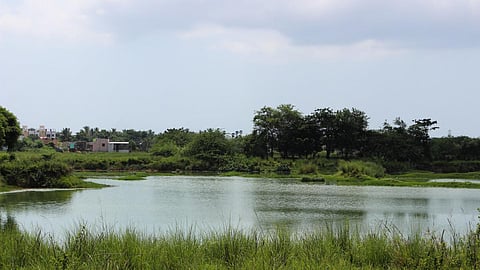
- Topics
- Feature
- Opportunities & Events
- About
- Hindi Portal
- Data
- Topics
- Feature
- Opportunities & Events
- About
- Hindi Portal
- Data

Greater Chennai Corporation has planned to set up 47 'sponge parks' to solve the issue of inundation of city roads. Work order for five such parks has been issued and another 42 will be tendered out this month.
The work will include construction of mini ponds and trenches at the park. The trenches will carry water from roads and stormwater drains into the pond. The pond will be surrounded by a wall and stone pitching along with fencing for safety. Inlet pipes will be created into the ponds that will collect water from drains, side of the roads and outlet pipes will drain out the excess of water. Rainwater harvesting structures with well rings inside the ponds will also be constructed to allow percolation of water, help tree plantations around the pond.
The sponge parks have been planned to not only solve the issue of floods, but also that of droughts and aim at equipping localities to be self sufficient in preventing flooding. The move will also recharge groundwater. The water can also be used for drinking in extreme cases (The Times of India).
Residents from around 40 villages of Jaisalmer, Rajasthan have walked 225 kilometres to protect community-conserved sacred spaces known as ‘orans’- now classified as biodiversity hotspots . Villagers walked to the district headquarters of Jaisalmer to submit a letter to the collector asking them to recategorise the area as ‘oran land’.
This is because loss of biodiversity in the region is affecting the livelihoods of the locals as large stretches of these lands, which receive long hours of sunlight and brisk winds, have become a hub of green energy with windmills and are being allotted for setting up solar plants.
The 'orans' are valuable habitats as they are among the last natural habitats of the endangered great Indian bustard (Down to Earth)
A court-appointed committee, led by a senior retired judge, has now confirmed for the first time by providing statistical evidence that illegal rat-hole coal mining continues in Meghalaya, inspite a blanket ban imposed since 2014.
These findings confirm the allegations made by activists and observers that court orders extending the deadline for the transportation of coal that was mined before the ban came into force, had helped fresh mining to happen in violation of the law.
The Meghalaya High Court has confirmed that the latest findings prove that “13 lakh MT of coal was illegally mined, transported and discovered which the state sought to pass off as coal mined prior to the imposition of the ban” (The Scroll).
Use of sugarcane for ethanol production is receiving a big push by the central government in India. This is leading to a transition in sugar mills in Maharashtra with the thrust of the Indian government being on biofuel.
Many of these mills have started diverting the ethanol produced in their mills to be used as a biofuel which can be blended with petrol under the National Ethanol Blending Programme (EBP). Many are also using bagasse to produce electricity and using other by-products to make more profits at their end.
Sugarcane farmers, however claim that this increase in demand for sugarcane has not had any positive impact on their income levels. While states like Maharashtra pay their farmers Fair and Remunerative Price (FRP), some states like Uttar Pradesh pay through what is called the State Advised Price (SAP), which is set by the state government and is often more than the FRP. (Mongabay, India)
Odisha has one of the highest fish consumption populations in India and it imports around 40,000 metric tonnes of fish annually, from neighbouring states.
To meet the increasing demand for fish in the state, ninety six entrepreneurs from across Odisha have taken up cage fish farming under the state’s subsidised policy. Experts informs that cage farming provides an assured production of 20-40 kgs of fish/cubic metre. For cage farming, cages of different dimensions and shapes are used with intricate net walls allowing the exchange of fresh water, with an opening on the top for feeding and maintaining the fish stock.
The pilot project has been initiated in Hirakud reservoir located in Sambalpur district (Mongabay, India)
This is a roundup of important news published from December 11 - December 31, 2022.
Also view our policy matters this fortnight